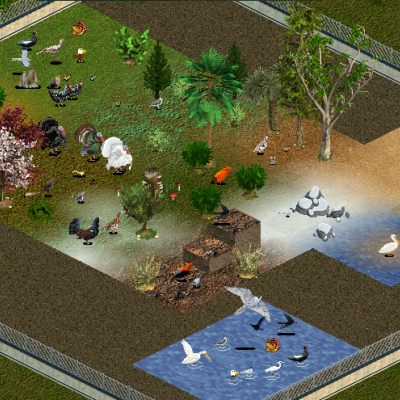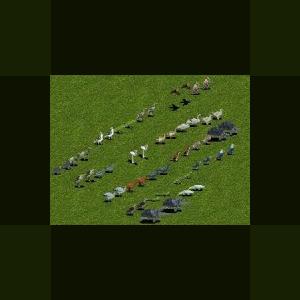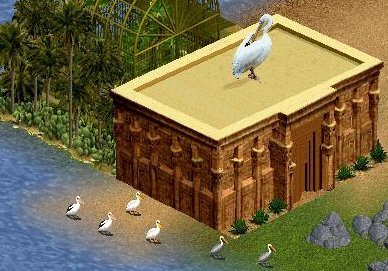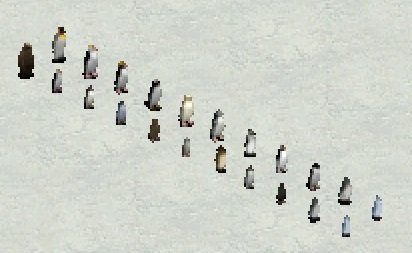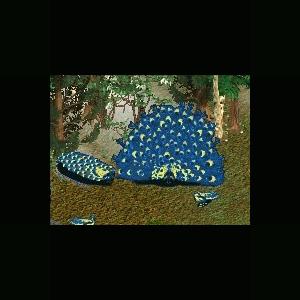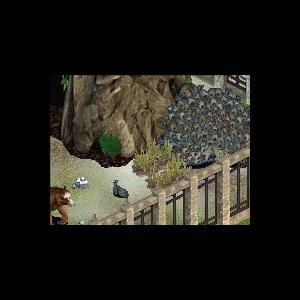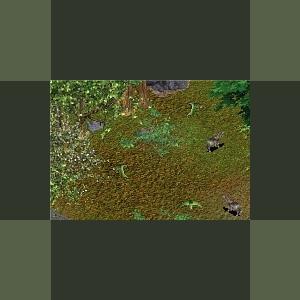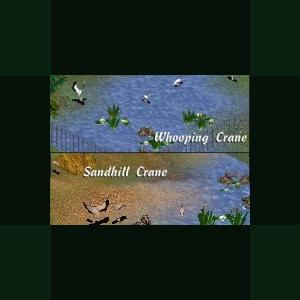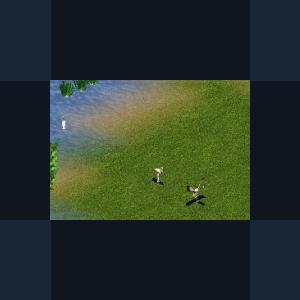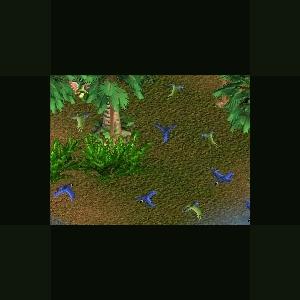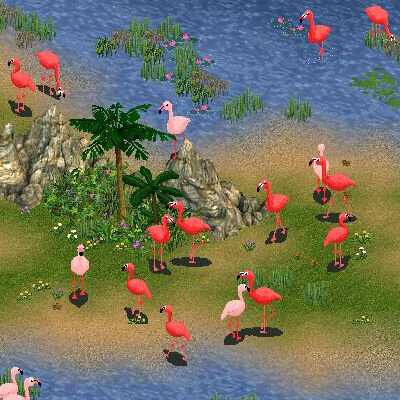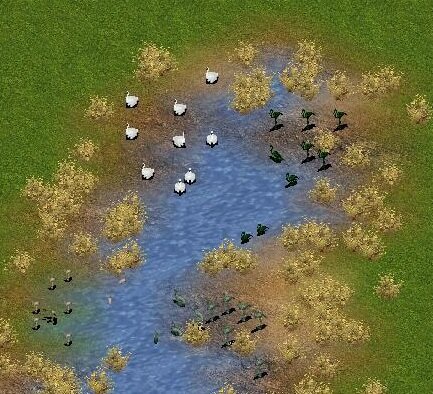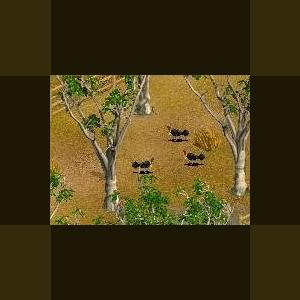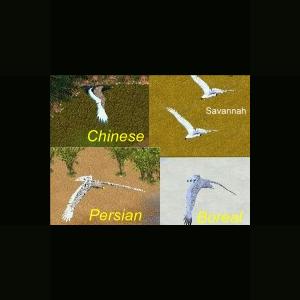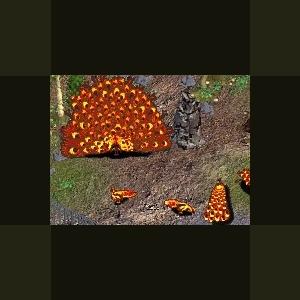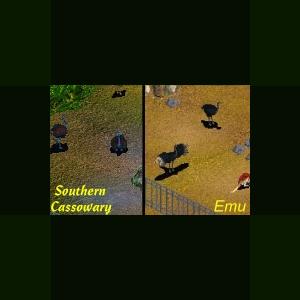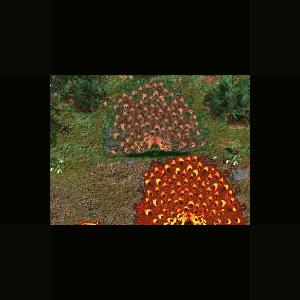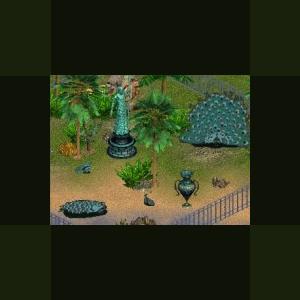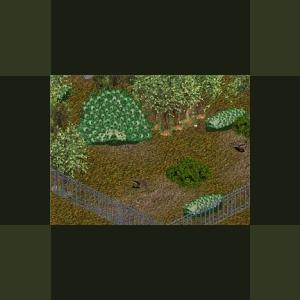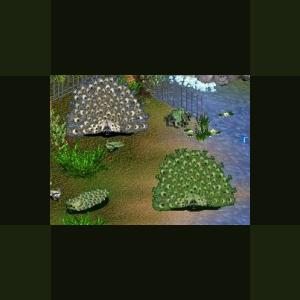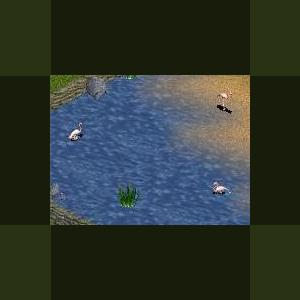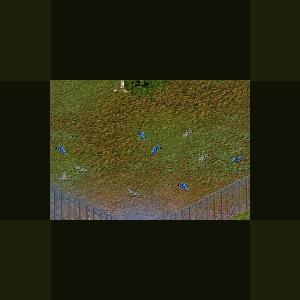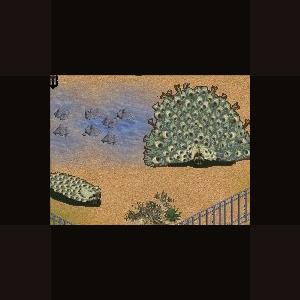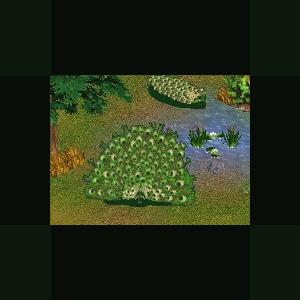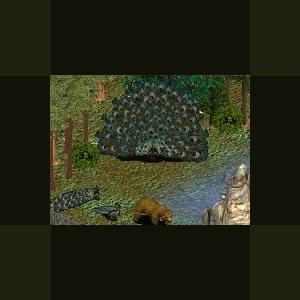Birds
Creatures on the wing
65 files
-
Birds - Part One by William
By William
Updated by Cricket on November 27, 2015:
A newer version has been attached. Although these may seem ok in-game, more work still needs to be done to ensure that they won't crash the game.
Various birds and other animals to use on your zoos
Contents:
Grassland (11):
Great white egret
Shih-tzu
Hen harrier
Muscovy duck
Red-legged seriema
Isa
Pidgeotto
Barn swallow
Yorkshire terrier
Deciduous forest (7):
Turkey
White turkey
Black turkey
Lyrebird
Reeves' pheasant
Baltimore oriole
Cuckoo
Coniferous forest (2):
Osprey
Bohemian waxwing
Boreal forest (1):
Capercaillie
Rainfores (1):
Guianan cock-of-the-rock
Scrub (3):
Chukar partridge
Koala
California quail
Highland (5):
Gray starling
Swift
Clark's nutcracker
Andean cock-of-the-rock
Rock pigeon
Tundra (1):
Arctic tern
Desert (6):
Great kiskadee
Peregrine falcon
Budgerigar
Cockatiel
Cactus wren
Desert finch
Many (1):
Pigeon
Aquatic (1):
Pelican
515 downloads
Updated
-
Mascarene Animal Pack by And 1
By Guest
The Mascarene Animals Pack contains 26 new animals of the Islands Mauritius, Reunion and Rodrigues.
Updated 2010-11-21
Just to save space with less in zip and smaller image.
Nothing new.
718 downloads
Updated
-
Pelicans by msc3323
By Fern
Pelicans by msc3323
Description: The three pelicans created by msc3323:
Author: Original graphics and configuration by msc3323; graphic and configuration adjustments by Jay; combined ztd by fern
Australian Pelican: This species can occur in large expanses of mainland Australia and Tasmania. Australian pelicans occur primarily in large expanses of open water without dense aquatic vegetation.
Updated 26 May 2019: Removed unnecessary files and lines, changed the preferred habitat to Aquatic, changed the food to fish, reduced the needed number of squares per adult to 5.
Current AustralianPelican_by_msc3323.ztd dated 26 May 2019
Brown Pelican: The brown pelican (Pelecanus occidentalis) is a North American bird of the pelican family, Pelecanidae. It is one of three pelican species found in the Americas and one of two that feed by diving in water.
Updated 28 May 2019: Removed unnecessary files and lines, changed the preferred habitat to Aquatic, changed the food to fish, reduced the needed number of squares per adult to 5.
Current BrownPelican_by_msc3323.ztd dated 28 May 2019
Great White Pelican: This is what you all waiting for ;) the great white pelican. The great white pelican (Pelecanus onocrotalus) also known as the eastern white pelican, rosy pelican or white pelican is a bird in the pelican family. It breeds from southeastern Europe through Asia and Africa, in swamps and shallow lakes.
Updated 29 May 2019: Removed unnecessary files and lines, changed the preferred habitat to Aquatic, changed the food to fish, reduced the needed number of squares per adult to 5.
Current Great_White_Pelican_by_msc3323.ZTD dated 29 May 2019
The downloadable file contains a combined .ztd file and the individual .ztd files. (If you use the combined file, you do not need the individual files)
316 downloads
Updated
-
Penguin Pack by Hawkkeye
By Fern
Compatibility: All Game Versions
Description: 13 penguins. Prey lines are deleted from .ztd file, so penguins are not gonna kill and destroy everything you love and cherish.
From left to right: King Penguin, Royal Penguin, Macaroni Penguin, Gentoo Penguin, Yellow-Eyed Penguin, Chinstrap Penguin, African Penguin, Fiordland Penguin, Adélie Penguin, Galapagos Penguin, Little Penguin.
And two late additions: Magellanic Penguin and Northern Rockhopper Penguin (mini screen)
File contains single ztds and a combined ztd
254 downloads
Updated
-
Swedish Proud Peafowl by Genkicoll
By Guest
Swedish Proud Peafowl
You might ask why these peafowl are so proud. Can they be more proud than your average peafowl? Perhaps so, but the reason why these particular peafowl carry the name of "proud" is that they display the colors of the Swedish flag.
The Swedish Peafowl's home is generally a forested area that contains a water source and abundant plant life. The winter snow seems to have little effect on these lovely birds, for they thrive in their natural habitat.
NOTE: 100% compatible with the Nordic Moose by Jordan
Updated 2010-11-21
Just to save space with less in zip and smaller image.
Nothing new.
301 downloads
Updated
-
Pavo Primoris Peafowl by Genkicoll
By Guest
Peafowl that we're commonly familiar with are found in India and Java. It came as a great surprise to scientists when they found the dna of a bird that was related to the decorative birds; in South America, no less.
Successfully hatching and raising a cock and three hens, the scientist noted differences in both size and habits. The peahens are 4.6 feet long and weigh 9lbs. Males reach 12-13ft in full breeding plumage, weighing around 15lbs. The male's plumage is rather muted compared to the rather brilliant trails that the modern fowl wear. The 'eyes' of the male Pravo primoris' aren't fully developed. The darker parts not apparent, the lighter areas looking more like fern leaves than the part of an eye.
Pavo Primoris were placed with Megatherium, giant ground sloths, to great results. The birds congregate around the great mammal, feeding on stirred up insects, dropped fruit, and occasionally a scratch or two through droppings.
Megatherium don't seem to mind them; the birds' sharp eyes help it in spotting predators. The Pavo Primoris fare well, that is, as long as the Megatherium aren't grazing on the tree the Pavo are nesting/roosting in.
Pavo primoris' nesting habits are different than those of other Galliforms. They do in fact build nests in trees. They will gather fur, twigs, mud, and even the male's old tail feathers to build nests in large trees.
100% compatible with the in-game Giant Ground Sloth, these peafowl will be found in the Dino Digs adoption menu.
Many thanks to Jens of ZTU for allowing us to recolor Willie T's original peafowl, and to Sundance for thinking up the description
UPDATED July 3, 2009 to increase the peafowl's lifespan.
Updated 2010-11-21
Just to save space with less in zip and smaller image.
Nothing new.
302 downloads
Updated
-
Red Crowned Parrot by Genkicoll
By Guest
The Red-crowned Amazon, (Amazona viridigenalis) also known as Red-crowned Parrot, Green-cheeked Amazon, or Mexican Red-headed Parrot, is an endangered Amazon parrot native to northeastern Mexico. The current native wild population of between 1,000 and 2,000 is decreasing. The main threats to its survival are the illegal export of trapped birds from Mexico to the United States and the destruction of habitat.
Description
Their appearance is generally green with the most notable features being a bright red forehead and crown, dark blue streaks behind the eyes, and light green cheeks.
Range
Their natural range is across the lowlands of northeastern Mexico. Feral birds have been introduced to urban communities of southern California and southern Florida. Birds in the Rio Grande Valley of Texas may be either feral or vagrants from Mexico.
Behaviour
They gather in large flocks being noisiest in the morning and evening. The characteristic screeching heard of these birds usually occurs when they travel in a large flock to a new feeding area. Diet consists of seeds, fruits, flowers and nectar. Red-crowned Amazons nest in tree cavities like most other parrots.
Aviculture
This parrot is often kept as a pet and can be very affectionate and playful when given the attention they need from their owners. Although some are excellent talkers, they are best at mimicking sounds.
References
* BirdLife International (2004). Amazona viridigenalis. 2006 IUCN Red List of Threatened Species. IUCN 2006. Retrieved on 11 May 2006. Database entry includes a range map, a brief justification of why this species is endangered, and the criteria used.
* "National Geographic" Field Guide to the Birds of North America ISBN 0-7922-6877-6
* Handbook of the Birds of the World Vol 4, Josep del Hoyo editor, ISBN 84-87334-22-9
* "National Audubon Society" The Sibley Guide to Birds, by David Allen Sibley, ISBN 0-679-45122-6
*100% compatible with the in-game Mexican Gray Wolf.
Updated 2010-11-21
Just to save space with less in zip and smaller image.
Nothing new.
374 downloads
Updated
-
Whooping and Sandhill Crane by Genkicoll
By Guest
Whooping Crane
The whooping cranes' breeding habitat is the muskeg of the taiga; the only known remaining nesting location is Whooping Crane Summer Range in Wood Buffalo National Park in Alberta, Canada and the surrounding area. With the recent Whooping Crane Eastern Partnership Reintroduction Project, whooping cranes nested naturally for the first time in 100 years in the Necedah National Wildlife Refuge in Central Wisconsin, USA. They nest on the ground, usually on a raised area in a marsh. The female lays 1 or 2 eggs, usually in late-April to mid-May. The blotchy, olive-colored eggs average 2½ inches in breadth and 4 inches in length (60 by 100 mm), and weigh about 6.7 oz (190 g). The incubation period is 29–35 days. Both parents brood the young, although the female is more likely to directly tend to the young. Usually no more than one young bird survives in a season. The parents often feed the young for 6–8 months after birth and the terminus of the offspring-parent relationship occurs after about 1 year.
Breeding populations winter along the Gulf coast of Texas, USA near Corpus Christi on the Aransas National Wildlife Refuge, Matagorda Island, Isla San Jose, and portions of the Lamar Peninsula and Welder Point, which is on the east side of San Antonio Bay.
Up to 75% of the nations population pass through Salt Plains National Wildlife Refuge in Oklahoma annually.
The whooping crane is endangered mainly as a result of habitat loss. At one time, the range for these birds extended throughout midwestern North America. In 1941, the wild population consisted of 21 birds. Since then, the population has increased somewhat, largely due to conservation efforts. As of April 2007 there were about 340 whooping cranes living in the wild, and another 145 living in captivity. The whooping crane is still one of the rarest birds in North America. The United States Fish and Wildlife Service confirmed that 266 whooping cranes made the migration to Aransas National Wildlife Refuge in 2007.
These birds forage while walking in shallow water or in fields, sometimes probing with their bills. They are omnivorous and slightly more inclined to animal material than most other cranes. In their Texas wintering grounds, this species feeds on various crustaceans, mollusks, fish (such as eel), berries, small reptiles and aquatic plants. Potential foods of breeding birds in summer include frogs, small rodents, smaller birds, fish, aquatic insects, crayfish, clams, snails, aquatic tubers and, berries. Waste grain, including wheat and barley, is an important food for migratory birds such as the whooping crane.
Sandhill Crane
The Sandhill Crane (Grus canadensis) is a large crane of North America and extreme northeastern Siberia. The common name of this bird references habitat like that at the Platte River, on the edge of Nebraska's Sandhills in the American midwest. This is the most important stopover area for the Lesser Sandhill Crane, Grus (canadensis) canadensis, with up to 450,000 of these birds migrating through annually.
Adults are gray overall; during breeding, the plumage is usually much worn and stained, particularly in the migratory populations, and looks nearly ochre. The sandhill crane has a red forehead, white cheeks and a long dark pointed bill. Its long dark legs trail behind in flight, and the long neck is kept straight in flight. Immature birds have reddish brown upperparts and gray underparts. The sexes look alike. Size varies among the different subspecies. This crane frequently gives a loud trumpeting call that suggests a French-style "r" rolled in the throat, and they can be heard from a long distance.
Mated pairs of cranes engage in "unison calling." The cranes stand close together, calling in a synchronized and complex duet. The female makes two calls for every single call of the male.
The only other large grayish-bodied bird of North America is the Great Blue Heron. This heron is of similar dimensions to the Sandhill Crane and is sometimes mistakenly called a crane, even though it is very different in plumage details and build. Like other herons, it flies with its neck tucked toward the body.
The sandhill crane's large wingspan, which is 6-8 feet when fully grown, makes this a very skilled soaring bird similar in style to hawks and eagles. Utilizing thermals to obtain lift, they can stay aloft for many hours, requiring only occasional flapping of their wings and consequently expending little energy. With migratory flocks containing hundreds of birds, they can create clear outlines of the normally invisible rising columns of air (thermals) that they ride.
Although it is rare, some Sandhill Cranes have been spotted devouring their young. If the mated pair recognizes a weakness in a young bird, they will eat it.[citation needed]
The Sandhill Crane flies south for the winter. In their wintering areas they form flocks of over 10,000 birds. One place to observe this is at Bosque del Apache National Wildlife Refuge, 100 miles south of Albuquerque, New Mexico. Just before Thanksgiving every year there is a Sandhill Crane Festival there. Use a search engine and get the information and go to this natural wonder.
Source: Wikipedia
*Included are both the separate ztds and a combined ztd. If you are using the combined ztd, you will not need to have the individual ztds in your game.
Updated 2010-11-21
Just to save space with less in zip and smaller image.
Nothing new.
645 downloads
Updated
-
American Wood Stork by Rhyno and LAwebTek
By Guest
The stork is a long-legged wading bird found in warmer parts of the world. Storks are related to the heron and the ibis, having long broad powerful wings, and during flight they flap their wings and soar with their legs dangling and their long necks bent back in a S shape.
Storks feed on reptiles, amphibians, mollusks, fish, and insects. They use their long heavy bills to catch food, by jabbing and thrusting like a knife. They do not have any syrinx muscles, which makes them mute, but they can produce a cluttering noise by snapping there bills.
In America the wood ibis, or American wood stork is the only species of stork found. It is about 4 ft. long with glossy greenish black tail, found in temperate and tropical regions.
2003 Programmed by Ryno & LAwebTek
Updated 2010-11-17
Just to save space with less in zip and smaller image.
Nothing new.
505 downloads
Updated
-
Hyacinth Macaw and Blue-headed Parrot by Genki
By Guest
The Hyacinth Macaw and the Blue-headed Parrot are 100% compatible with each other and with the Paca made by Ghirin
Hyacinth Macaw
The Hyacinth Macaw is 100 cm (39 in) long and 1.5–2 kg (3.3-4.4 lb) in weight. The wingspan is 120-140 cm (48-56 in). It is almost entirely blue and has black under the wings. It has a large black beak with bright yellow along the sides of the lower part of the beak and also yellow circling its eyes. The female and male are nearly indistinguishable, although the female is typically a bit more slender.
Food and feeding
They have a very strong beak for eating their natural foods, which include the kernel of hard nuts and seeds. Their strong beaks are even able to crack coconuts and macadamia nuts. In addition, they eat fruits and other vegetable matter. Pine nuts are also one of the most popular foods. They will also take snails.
Reproduction
These birds nest in existing holes in trees. The clutch size is one or two eggs, although usually only one fledgling survives as the second egg hatches several days after the first, and the smaller fledgling cannot compete with the first born for food. Juveniles stay with their parents until they are three months old. They are mature and begin breeding at seven years of age. Eggs are regularly predated by corvids, possums, coatis and (most prolifically) toucans. Adults have no known natural predators.
Distribution and habitat
The Hyacinth Macaw survives today in three main populations in South America: In the Pantanal region of Brazil, and adjacent eastern Bolivia and northeastern Paraguay, in the Cerrado region of the eastern interior of Brazil (Maranhão, Piauí, Bahia, Tocantins, Goiás, Mato Grosso and Minas Gerais), and in the relatively open areas associated with the Tocantins River, Xingu River, Tapajós River, and the Marajó island in the eastern Amazon Basin of Brazil. It is possible that smaller, fragmented populations occur in other areas. It prefers palm swamps, woodlands, and other semi-open wooded habitats. It usually avoids dense humid forest, and in regions dominated by such habitats, it is generally restricted to the edge or relatively open sections (e.g. along major rivers).
Conservation
The Hyacinth Macaw is an endangered species due to overcollection for the cage bird trade and habitat loss. Annual grass fires set by farmers can destroy nest trees, and regions previously inhabited by this macaw are now unsuitable due to cattle-ranching, hydroelectric power schemes, agriculture and plantations. Locally, it has been hunted for food, and the Kayapo Indians of Gorotire in south-central Brazil use its feathers to make headdresses and other baubles. While overall greatly reduced in numbers, it remains locally common in the Brazilian Pantanal, where a specific program, the Hyacinth Macaw Project, among others involving artificial nests and awareness campaigns, has been initiated by several ecolodges, and many ranch-owners now protect the macaws on their land.
Source: Wikipedia
Blue-headed Parrot
The Blue-headed Parrot, also known as the Blue-headed Pionus, Pionus menstruus, is a medium large parrot. It is about 27 cm long and they are mainly green with a blue head and neck, and red under tail feathers. It is a resident bird in tropical and subtropical South America and southern Central America, from Costa Rica, Venezuela and Trinidad south to Bolivia and Brazil. It is named for its medium-blue head and neck.
Its habitat is forest and semi-open country, including cultivated areas. It is largely restricted to humid or semi-humid regions, but locally extends into drier habitats, at least along rivers. The Blue-headed Parrot lays three to five white eggs in a tree cavity.
Blue-headed Parrots are noisy birds and make light, high-pitched squeaking sweenk calls. They eat fruit and seeds, and sometimes grain. They roost communally in palm and other trees, and large numbers can be seen at the roost sites at dawn and dusk.
Blue-headed Pionus parrots are popular as pets. Compared to other parrot species (Amazons for example) they are very quiet. They are affectionate, but not known for their talking ability.
Description
The Blue-headed Parrot is about 28 cm (11 in) long and weighs 245 gm. It is mainly green with a blue head, neck and upper breast, red undertail coverts, and some yellowish on the wing coverts. The upper mandible is black with reddish areas on both sides. They have dark ear patches. In addition to the well-known nominate subspecies found throughout most of the species' South American range, there are two more localized subspecies: rubrigularis from southern Central America and the Chocó has an overall paler plumage and typically a relatively distinct pinkish patch on the throat, and reichenowi from the Atlantic Forest in east Brazil has a paler bill and most of the underparts blue. In all subspecies the male and the female are alike, and juvenile birds have less blue on the head, as well as red or pinkish feathers around the ceres. They moult into their adult plumage at about 8 months of age, but it can take up to two years for the full blue hood to emerge.
Range
In South America, the Blue-headed Parrot is mainly an Amazonian species, including in the southeast the neighboring Araguaia-Tocantins River system as its eastern limit; a disjunct population lives southeastwards on Brazil's South Atlantic coast, a coastal strip from Pernambuco in the north to Espírito Santo state in the south, about 1500 km long. In northwest South America the range continues into Central American Panama to Costa Rica. It avoids the northern Andes cordillera spine, and a smaller contiguous area of central Venezuela and northern Colombia. A Pacific Ocean coastal strip continues the range, from southern Ecuador, north to Caribbean areas of northwestern Colombia and western Venezuela.
Food and feeding
They eat fruit and seeds, and sometimes grain.
Breeding
The Blue-headed Parrot nests in tree cavities. The eggs are white and there are usually three to five in a clutch. The female incubates the eggs for about 26 days and the chicks leave the nest about 70 days after hatching.
Source: Wikipedia
Updated 2010-11-21
Just to save space with less in zip and smaller image.
Nothing new.
852 downloads
Updated
-
Flamingo Mini-Pack by msc3323
By Cricket
This Mini-Pack contains the American Flamingo and the Rosy Flamingo (Greater Flamingo). Unfortunately they are somewhat big, but real beauties.
Updated by Jay in May of 2020:
From Jay:
Here is the updated flamingo mini pack. Since I do not like apostrophes or spaces in zip file names, I removed the apostrophe and changed the spaces to underscores. Although I do not like apostrophes or spaces in ztd file names either, I did not change that file name. I added English animal info, put the German animal info into paragraphs, reduced the amount of space needed for the flamingos, changed the location for the American Flamingo from Africa to North America, changed the needed food from hay to fish, added the small rock as a specifically liked rock, changed the Rosy Flamingo name in English to Greater Flamingo, and removed unnecessary files and configuration lines.
91 downloads
Updated
-
Great Blue Heron~Black Stork~Long-billed Crulew~Trumpeter Swan by Genkicoll
By Savannahjan
Also includes scrub brush foliage, preferred by the Long-billed Curlew.
The largest and most widespread heron in North America, the Great Blue Heron can be found along the ocean shore or the edge of a small inland pond. Although the Great Blue Heron eats primarily fish, it is adaptable and willing to eat other animals as well. It nests in colonies, sometimes as a lone pair.
Source: http://www.allaboutbirds.org/guide/Great_Blue_Heron/lifehistory
The Black Stork has shining black with iridiscent reflections. The rest of the plumage is pure white with red beak and feet. It can be found hroughout Europe, north to Scandinavia and west to Russia, and is primarily a forest species hunting in streams, small rivers and marshy ponds. The diet consists almost completely of small fish; also small mammals, reptiles, shellfish and insects.
The Long-billed Curlew (Numenius americanus) is the largest shorebird in North America. It breeds in shortgrass or mixedgrass to very dry grasslands. Long-billed Curlews are a late-maturing, long-lived species with low reproductive output. Eggs are olive-buff and are evenly spotted with brown or gray.
Source: http://www.abheritage.ca/abnature/speciesatrisk/curlew_intro.htm
The Trumpeter Swan, Cygnus buccinator, is the largest native North American bird, and the largest living waterfowl species on earth. These birds have white plumage with a long neck, a black bill subtly marked with salmon-pink along the mouthline, and short black legs. They feed while swimming. The diet is almost entirely aquatic plants. The Trumpeter Swan is listed as threatened in the state of Minnesota.
Inspired by the Zoo Tycoon Brains Trust at Zoo Tek Phoenix.
Updated 2010-11-21 to save space with less in zip.
59 downloads
0 comments
Submitted
-
Australian Brush-Turkey by And 1
By Guest
new Bird for your Game. Made by And 1
The Australian Brush-turkey Alectura lathami, also frequently called the Scrub Turkey or Bush Turkey, is a common, widespread species of mound-building bird from the family Megapodiidae found in eastern Australia from Far North Queensland to Illawarra in New South Wales. It has also been introduced to Kangaroo Island in South Australia. It is the largest extant representative of the family Megapodiidae and is one of three species to inhabit Australia. Despite its name, the bird is not closely related to American turkeys. It is a spectacular large bird with a prominent, fan-like tail flattened sideways. The Brush-turkey is mainly black but has a bare red head, and a yellow or bluish-grey wattle. Their undersides are sprinkled with white feathers, more pronounced in older birds. The Brush-turkey flies very clumsily with heavy flapping when it is frightened and roosts in trees at night and during the heat of the day. The adult Brush-turkey is 60-75 cm in length, with predominantly black body plumage, with a wingspan of about 85 cm. It has a featherless red head and a yellow throat wattle. The male's wattle becomes much larger during breeding season, often swinging from side to side as they run. The males' red heads and yellow wattles also become much brighter during the breeding and nesting season. A smaller race, purpureicollis, lives in northern Cape York Peninsula. It has bluish-white wattles.
Brush-turkeys are communal birds, and have communal nests. A typical group consists of a dominant male, one or more younger males and several females. They build large nests on the ground made of leaves, other combustible material and earth, 1 to 1.5 metres high and up to 4 metres across. The eggs are hatched by the heat of the composting mound which is tended only by the males who regulate the temperature by adding or removing material in an effort to maintain the temperature of the mound in the 33-35°C incubation temperature range [1]. The Australian Brush-turkey checks the temperature by sticking its beak into the mound. As with some reptiles, incubation temperature affects the sex ratio of chicks, which is equal at 34°C but results in more males when cooler and more females when warmer (p=0.035). It is unclear whether the parents use this to manipulate the sex of their offspring by, for instance, selecting the nesting site accordingly. Warmer incubation also results in heavier, fitter chicks (p<<0.0001), but how this is linked to gender is also unknown. The same nesting site is frequently used year after year, the old ones being added to each breeding season. The average clutch of eggs is between 16 and 24 large white eggs, which are laid September to March. Sometimes up to 50 eggs laid by several females may be found in a single mound. The eggs are placed in a circle roughly 60-80 cm down, 20-30 cm apart, always with the large end up. The newly hatched young dig themselves out of the mound and then have to look after themselves. Brush-turkey eggs are a favourite food of goannas, snakes, dingoes and dogs and once were a staple of Aboriginal Australians. Often goannas exhibit wounds on their tails of having been pecked by Brush-turkeys who ferociously chase them away from their nests.In situations where they come into contact with humans, such as picnic areas in national parks, brush-turkeys exhibit little fear and will often boldly attempt to steal food from tables. They will nest in suburban gardens, and in search of material for their nests will patiently remove enormous amounts of mulch from neighbouring gardens.
Text by wikipedia.org
Updated 2010-11-17
Just to save space with less in zip and smaller image.
Nothing new.
637 downloads
0 comments
Updated
-
Rocs by Ghirin
By Guest
All four of the great mythical birds by Ghirin in one zip file. Also includes a combined ztd for your convenience.
Chinese Roc:
The roc (also known as the rukh) is a mythical bird that resembles an enormous eagle. The roc is so large and strong that it is able to lift adult elephants off of the ground, then send them back to earth to their deaths. Tales of rocs have been described in both the writings of Marco Polo and the voyages of Sinbad.
The roc of China is the most colorful of the roc species.
Reference:
www.wikipedia.org
Boreal Roc:
The roc (also known as the rukh) is a mythical bird that resembles an enormous eagle. The roc is so large and strong that it is able to lift adult elephants off of the ground, then send them back to earth to their deaths. Tales of rocs have been described in both the writings of Marco Polo and the voyages of Sinbad.
The boreal roc lives in the artic regions and enjoys hunting musk ox and caribou.
Reference:
www.wikipedia.org
Persian Roc:
The roc (also known as the rukh) is a mythical bird that resembles an enormous eagle. The roc is so large and strong that it is able to lift adult elephants off of the ground, then send them back to earth to their deaths. Tales of rocs have been described in both the writings of Marco Polo and the voyages of Sinbad.
The Persian roc is the largest of the roc species and is found in southern Eurasia.
Reference:
www.wikipedia.org
Savannah Roc:
The roc (also known as the rukh) is a mythical bird that resembles an enormous eagle. The roc is so large and strong that it is able to lift adult elephants off of the ground, then send them back to earth to their deaths. Tales of rocs have been described in both the writings of Marco Polo and the voyages of Sinbad.
The savannah roc is the smallest of the rocs and can be seen soaring above the East African plains.
Reference:
www.wikipedia.org
Updated 2010-11-21
Just to save space with less in zip and smaller image.
Nothing new.
730 downloads
0 comments
Updated
-
Pyro Peafowl by Genkicoll
By Guest
The pyro peafowl is seldom seen in nature. Perhaps it is because they live in areas where volcanic eruptions and lava flows are common. These peafowl seem to thrive on the heat given off by volcanic activity, though they do need a nearby source of water. They require a highland habitat with some vegetation, and love geysers and volcanoes in their exhibit.
Compatible with other fiery animals, such as the volcanic unicorn, pyro zebra and fire horse.
Many thanks to Jens of ZTU for allowing us to recolor Willie T.'s original Indian Peafowl!
Updated 2010-11-21
Just to save space with less in zip and smaller image.
Nothing new.
295 downloads
0 comments
Updated
-
Southern Cassowary and Emu by Genkicoll
By Guest
Australia's most spectacular bird would have to be the cassowary, up to two metres tall, covered in coarse black double stranded feathers, and with brilliant colors of red and blue on its neck and head. This elusive flightless bird is highly endangered and lives only in the Wet Tropics area of North Queensland and another patch of remote rainforest high up on the Cape York peninsula.
The cassowary (Casuarius casuarius johnsonii) has been wandering around this planet since before the super continent Gondwana broke up in to several continents, and they have relatives in several distant continents. They belong to a family of birds called ratites and are related to the Emu, the Ostrich, the Kiwi (though there is a dramatic difference in size) and the South American Rhea - a little known bird that resembles a small emu and runs around plains in Patagonia. They are also related to the now extinct Moas of New Zealand and the Elephant Bird of Madagascar. In New Guinea there are two other species of cassowary too but in Australia the only species is the Southern Cassowary.
Cassowaries (genus Casuarius) are frugivorous; fallen fruit and fruit on low branches is the mainstay of their diet. They also eat fungi, insects, frogs, spiders, snakes and other small animals, even dead ones and roadkills. They live for about 40-50 years. They are the second-largest bird in Australia and the third-largest remaining bird in the world (the ostrich and emu are larger). "Cassowary" originates from the Malay name kesuari.
The birds grow to 1.5 - 1.8 m tall, though the females are larger and can reach 2 m and they weigh about 60 kilograms, but the heaviest recorded was 83kg. They have a bony casque on the head that is used to batter through underbrush, this is made of keratin, the same material as our nails and hair. The casque is also used for headbutting and some people believe it is used to receive the very low frequency humming noise that they can make.
Usually cassowaries are very shy but when they feel threatened or want to protect their young they can lash out dangerously with their powerful legs and jump and kick with both legs at once. Their three-toed feet have sharp claws; the dagger-like middle claw is 12 cm long. Cassowaries are very capable of killing dogs by disemboweling them and have injured people, though only one death has been recorded, more on this on cassowary attacks. They can run up to 50 km/h and jump up to 1.5 m. They are also good swimmers.
They don't have much of a family life, they are solitary birds but females will cruise around the forest mating with several males during the breeding season from May to November. Courtship is initiated by the male when a female enters his territory. The smaller sized male must approach the larger female with caution because if she is not in the mood she is capable of seriously injuring him. The male begins courtship by circling around the female and making a low rumbling sound. When she has laid her eggs, three to eight, measuring about 90 by 140 mm and pale green-blue in color, in a shallow scrape in the ground in which the male has placed leaves and grass, she moves on again to repeat the process with another male. It is the male's duty to incubate the eggs for about fifty days and also to care for the chicks for another year or so. The chicks are striped until they are about 6-9 months old and become a glossy black colour when they are about 3 years old. By that time, the skin on the neck and head begins to turn color, and the casque begins to develop. Cassowaries are capable of breeding when they are three years old.
Source: http://www.rainfores...n/cassowary.htm
The Emu is a large native Australian bird that cannot fly. It is similar in appearance to the Ostrich, which also cannot fly; in fact, the Emu is in the same family as the African Ostrich and the South American Rhea. They have grey-brown feathers, a pale-blue neck and face, long powerful legs and three toes (ostrich's only have two!). Emus are the world's third largest living bird. Only the Ostrich and Cassowary are slightly larger.
Habitat
Emus live in small mobs and feast on a simple diet of grasses, seeds, fruit, flowers and small insects. They drink water regularly, at least once a day in winter and twice a day in summer and sometimes drink up to four gallons a day. Therefore they can usually be found within walking distance of water. When drinking they can take up to 70 mouthfuls of water and they lift their head after each one. They prefer flat country where there is enough rain each year to fill the waterholes, but will move into desert areas after the rain.
Emus have survived over 80 million years in the deserts, forests and plains of Australia. There used to be three species of Emu, but two became extinct after European settlers came to Australia.
Emus can be found in most areas of Australia, except for the East coast.
An average adult male Emu is between 1.5-2 metres tall, and weighs between 35 and 50 kilograms. The female Emu is even larger but they have a life span of only six years. Because the Emu has strong, long legs, they are a very fast running bird and can run up to 60 kilometres an hour over short distances, while their stride is about 3 metres long. They also use their legs to kick at animals or humans that try to attack.
Breeding
Emus mate when they are about eighteen months old. The female lays between five and fifteen eggs that weigh up to one kilogram each. She will usually lay them on trampled grass or in a hollow in the ground. She leaves the eggs in the care of the male Emu, while she often finds another mate and lays another set of eggs.
Meanwhile male Emu builds up the nest, which can be up to two metres wide, from leaves, grass and bark. The eggs are dark green in colour and are sometimes collected by people as display pieces. Animals such as foxes, dingoes, eagles and even lizards will also seek out the eggs as a food source.
The male incubates the eggs for a period of seven to eight weeks, turning the eggs over once a day, and does not leave the nest during this time. If the female approaches the eggs, the male chases her away. Female Emus have been known to kill their chicks.
When the eggs hatch, the male Emu cares for the striped chicks for up to six months. The chicks can walk within twenty-four hours of being hatched. The female Emu does not care for the eggs nor does she care for the chicks.
Population
Emus moved farther away in the country when the settlers built towns and farms, and when foxes and cats were introduced into Australia they attacked and killed many emus. In the 1930's in Western Australia teams of army machine-gunners killed many Emus in an effort to maintain the farmers' valuable wheat crops. Despite this, Emu numbers managed to thrive, and there is currently a healthy Emu population in Australia, with more emus now than there were 200 years ago. Farmers today are allowed to breed and raise Emus for meat, leather, and oil. Emu oil is used in the treatment of muscle and joint pains, such as arthritis, and also in cosmetics.
Interesting Facts
The Emu, along with the Kangaroo, is featured on the Australian Coat Of Arms – these 2 animals were chosen for the honour because they can't travel backwards and can only move forwards. The Coat of Arms also appears on the Australian 50 cent coin.
Source: http://library.think.../birds/emu.html
This animal is 100% compatible with the in-game kangaroo.
Updated 2010-11-21
Just to save space with less in zip and smaller image.
Nothing new.
669 downloads
0 comments
Updated
-
Houou Phoenix and Firebird Peafowl by Genkicoll
By Guest
In Japan, as earlier in China, the mythical Phoenix was adopted as a symbol of the imperial household, particularily the empress. This mythical bird represents fire, the sun, justice, obedience, and fidelity.
According to legend (mostly from China), the Ho-oo appears very rarely, and only to mark the beginning of a new era -- the birth of a virtuous ruler, for example. In other traditions, the Ho-oo appears only in peaceful and prosperous times (nesting, it is said, in paulownia trees), and hides itself when there is trouble. As the herald of a new age, the Ho-Oo decends from heaven to earth to do good deeds, and then it returns to its celestial abode to await a new era. It is both a symbol of peace (when it appears) and a symbol of disharmony (when it disappears). In China, early artifacts show the Phoenix (female) as intimately associated with the Dragon (male) -- the two are portrayed either as mortal enemies or as blissful lovers. When shown together, the two symbolize both conflict and wedded bliss, and are a common design motif even today in many parts of Asia.
Source: http://www.onmarkproductions.com/html/ho-oo-phoenix.shtml
*Fully compatible with the in-game Japanese Serow
In Slavic folklore, the Firebird is a magical glowing bird from a faraway land, which is both a blessing and bringer of doom to its captor.
The Firebird is invariably described as a large bird in majestic plumage that brightly glows in red, orange and yellow light, like a bonfire that is just past the turbulent flame. The feathers do not cease glowing if removed, and one feather can light a large room if not concealed. In later iconography, the form of Firebird is usually as of a smallish peacock of fire colors, complete with a crest on its head and tail feathers with glowing "eyes".
A typical role of the Firebird in fairy tales is an object of difficult quest. The quest is usually initiated by finding a lost tail feather of the Firebird, upon which the hero sets out to find and capture the live bird, sometimes on his own accord, but usually on the bidding of a father or king. The Firebird is a marvel, highly coveted, but the hero, initially charmed by the wonder of the feather, eventually blames it for his troubles.
Prince Ivan returning on a magic carpet with the caged firebird.
The Firebird tales follow the classical scheme of fairy tale, with the feather serving as a premonition of hard journey, with magical helpers met on the way, who help in travel and capture of the Bird, and returning from the faraway land with the prize. The most popular version is found in the tale of Ivan Tsarevich and the Grey Wolf.
The story of Firebird quest has inspired literary works, including "The Little Humpback Horse" by Pyotr Yershov. Composer Stravinsky achieved an early success with a large-scale ballet score, The Firebird.
The Firebird concept has parallels in the Iranian legends of magical birds, in the Brothers Grimm's fairy tale about The Golden Bird and the related Russian magical birds like Sirin. The story of the quest itself is closely paralleled by Armenian Hazaran Blbul. In the Armenian tale, however, the bird does not glow but rather makes the land bloom through its song. In the Czech folklore, it is called Pták Ohnivák (Bird Fire-like) and appears, for example, in a Karel Jaromír Erben fairy tale, also as an object of difficult quest. Moreover, in the beginning of this fairy tale, the bird steals magical golden apples belonging to a king and is therefore pursued by the king's servants in order to protect the precious apples.
The story of the firebird comes in many different forms. Some folk tales say that the Firebird is a mystical bird that flies around a king’s castle and at night swoops down and eats all the king's golden apples. Others say that the firebird is just a bird that flies around giving hope to those who need it. Some additions to that legend say that when the firebird flies around his eyes sparkle and pearls fall from his beak. The pearls would then fall to the peasants, giving them something to trade for good or services. In the most common version of the legend, a Tsar commands his three sons to capture the firebird that keeps flying down from above and eating his apples. The golden apples are in the Tsar’s orchard and give youth and strength to all who eat them. The sons end up barely missing the bird, but they catch one of his feathers that glows in the night. They take it in a dark room and it lights the room completely. The mystery of the feather has illuminated hearts of men for many years.
Source: Wikipedia
Updated 2010-11-21
Just to save space with less in zip and smaller image.
Nothing new.
461 downloads
0 comments
Updated
-
Atlantean Peafowl by Genkicoll
By Guest
The Atlantean Peafowl is an odd little peafowl found on a string of islands found in the Atlantic ocean, near the Sargasso Sea, one of the places speculated that the mythical Atlantis might be.
The beautiful coloraton of this bird makes it very sought after, yet it's a hard one to keep. The reason? It prefers saltwater to freshwater. So much so that it refuses to drink anything but saltwater.
How does this bird survive on nothing but saltwater? It uses the same mechanics as the Saltwater Crocodile: it cries out tears of salt.
Another thing that makes this bird hard to keep is its nesting practices. It prefers to perch on stone, and nest in high stone crevices. Hens will not lay or brood if those requirements are not met.
A nice stone archway or a pedestal will fit those needs nicely. Where else would such a noble bird expect to perch?
Most enjoys the Palm Tree, Joshua Tree, Rainforest Fern, Water Lily, Water Reed Llala Palm Tree, Tall Grass and Sage Bush in its exhibit.
Updated 2010-11-17
Just to save space with less in zip and smaller image.
Nothing new.
611 downloads
0 comments
Updated
-
Argus Peafowl by Genkicoll
By Guest
The Argus Peafowl
Zeus was married to Hera, however, he fell in love with Io. Zeus had turned Io into a beautiful white bovine to hide her true identity from Hera. Zeus feared the intensity of Hera's jealousy and tried to hide himself and the heifer he loved by wrapping the earth in a dense cloud, thick enough to create constant night. With daylight suddenly missing from the earth, Hera knew that her obtuse husband was up to something. Searching the heavens to no avail, she descended to earth, ordering the cloud away. She found Zeus beside the white heifer, claiming he just discovered the newly born cow. Hera knew that Zeus was lying to her, but played his bluff and asked for the cow as a gift. Zeus felt terrible doing it, but he knew that Hera would suspect something if he didn't concede. He reluctantly turned Io over to his wife, and Hera knew exactly what to do to keep Io away from him.
Hera recruited Argus to guard the heifer. He had a hundred eyes and could sleep while always leaving some eyes open, making him the perfect watchman. Zeus writhed as misery engulfed his love. Io had been turned into a cow, taken from her home, and now trapped under Hera's orders. Unable to withstand Io's anguish, Zeus called on Hermes, the messenger of the gods, and informed him to find a way to kill Argus and set Io free. Hermes was extremely clever, shedding all his godly paraphernalia and went to Argus in the guise of a country fellow. Hermes decide to make a pipe of reeds his luring weapon of choice and played music close enough to draw Argus' attention. Argus found the music most pleasing and invited Hermes to sit beside him to play music for him.
The music however did not cause repose as Hermes hoped. Soon, Hermes stopped playing and began to talk and talk monotonously. This was nowhere near as enjoyable to Argus and he soon found himself bored as Hermes droned on and on with his mundane stories. The tale of Pan and Syrinx would finally lull Argus to sleep. Once the hundredth eye had shut, Hermes struck, killing Argus in his slumber.
Io was set free, until Hera would turn on her again, plaguing her with gad-flies that stung her into madness.
In tribute to her trusted watchman, Hera took the eyes of Argus and set them to the tail of her favorite bird, the peacock.
Updated 2010-11-17
Just to save space with less in zip and smaller image.
Nothing new.
605 downloads
0 comments
Updated
-
Java and Peach Peafowl by Genkicoll
By Guest
Java Green Peafowl:
The Java Green is a subspecies of the Green Peafowl (Pavo muticus) a true type species. Javanese peafowl are found in the wild as well as captivity, but it is estimated only 1,000 or so survive in their native habitat.
Green peafowl are taller and leaner than the blues, and brighter in color. The crest is tall and tightly bundled. The facial skin includes a region of light blue and a bright yellow loral patch. The head and neck are metallic green, the shoulders bluish-green, and the abdomen a dark green.
Females are much more brightly colored than those of the India Blue. They are very similarly colored to the males, but the green are slightly muted and less brilliant. They do not have a long train with ocelli, and their tail feathers have a heavy dark barring.
Java Green is one of the three subspecies of one of the three species of peafowl found naturally in the wild. They are the most commonly raised green subspecies in captivity. In the wild, they are found in Java and on the Malay Peninsula, but are greatly endangered.
Peach Cameo Peafowl:
Type of mutation: Cameo is a color mutation, and can also be combined with spaldings to create Cameo Spaldings.
Peacock Coloration: At the beginning of the season, males are dark brown in color, but by the time they begin to molt the sun has bleached them to a much lighter "coffee milk color." The neck remains a darker color than the rest of the body the entire year, and the train is darker in color than the wings, which exhibit brown and tan barring. The ocelli on the train have varying shades of brown, but no iridescence.
Peahen Coloration: Females are creamy brown and lighter than the males in color. Their heads and neck are a darker rust, and the color fades on the breast and back of the bird.
Peachick Coloration: Chicks look much like those of the India Blue, but are lighter in color, and are a creamy brown.
Origin: Cameo was the first color mutation discovered besides the white, and has been around for awhile. It was originally called the silver dun. Cameos originated in Maine in the 1960s, and were first bred by Oscar Mulloy. Sherman Cram, Dennis Cook, and Norman Waycott helped perfect the mutation.
Do they breed true?: Yes, cameo x cameo will produce 100% cameo chicks. However, like the purple, cameo is a sex linked mutation. This means that when a cameo cock is bred to any other type of hen, all the female offspring will be cameo and the males offspring India Blue split to cameo and the hen's color. Cameo hens cannot produce cameo offspring when bred to other types of males, only offspring split to cameo. Since the mutation has been along for many years, there is not a shortage of males like in the purples.
Source: http://database.amys...com/cameo.shtml
The Peach Cameo Peafowl and the Java Green Peafowl are 100% compatible.
Updated 2010-11-21
Just to save space with less in zip and smaller image.
Nothing new.
376 downloads
0 comments
Updated
-
Chilean Flamingo by Kiger Cowgirl
By Guest
Description : A well known member of the flamingo family, the Chillean flamingo has more intense plumage than the Greater flamingo, though not quite as large.
The Chilean flamingo's most noteable charachteristic is it's bright pink "knees".
Updated 2010-11-21
Just to save space with less in zip and smaller image.
Nothing new.
Updated by JohnT 2 July 2013 - fixed to correct all warnings and then some.
313 downloads
0 comments
Updated
-
Mountain Bluebird by Genkicoll
By Guest
The Mountain Bluebird (Sialia currucoides) is a medium-sized bird weighing about an ounce, with a length from 15-20 cm (6-8 in). They have light underbellies and black eyes. Adult males have thin bills. They are bright blue and somewhat lighter beneath. Adult females have duller blue wings and tail,fake grey breast, grey crown, throat and back.
Distribution and habitat
The Mountain Bluebird is migratory. Their range varies from Mexico in the winter to as far north as Alaska, throughout the western U.S. and Canada. Northern birds migrate to the southern parts of the range; southern birds are often permanent residents. Some birds may move to lower elevations in winter.
Feeding
These birds hover over the ground and fly down to catch insects, also flying from a perch to catch them. They mainly eat insects and berries. They may forage in flocks in winter, when they mainly eat grasshoppers.
Breeding
Their breeding habitat is open country across western North America, including mountain areas, as far north as Alaska. They nest in pre-existing cavities or in nest boxes. In remote areas, these birds are less affected by competition for natural nesting locations than other bluebirds. Females usually build the nests themselves.
It is the state bird of Idaho and Nevada.
References
* BirdLife International (2004). Sialia currucoides. 2006 IUCN Red List of Threatened Species. IUCN 2006. Retrieved on 12 May 2006. Database entry includes justification for why this species is of least concern
* All About Birds: Mountain Bluebird, Cornell Lab of Ornithology
http://www.birds.cornell.edu/AllAboutBirds/BirdGuide/Mountain_Bluebird.html
* Mountain Bluebird Information and Photos South Dakota Birds and Birding
**100% compatible with the striped skunk made by Jordan**
Updated 2010-11-21
Just to save space with less in zip and smaller image.
Nothing new.
326 downloads
0 comments
Updated
-
Nile Peafowl by Genkicoll
By Guest
The Nile Peafowl is a rare bird, or rather a rare coloration of the Indian Peafowl.
Birds of this color were pictured on tomb walls, thought to be stylized images of the normally blue or emerald colored bird.
Selectively bred to carry the colors of the desert, tempered gold, tan, teal, and black, these birds were no doubt found in royal gardens. The proud stature and magnificient tail would no doubt have made any grand garden livelier.
The bird itself seems resilient against the desert heat and the freezing nights. They greet the sun every morning with a lively choir, and give it farewell with quieter cooing.
Sadly, this proud bird has been pushed into obscurity by the demise of its kingdom. It was happenstance that an Egyptologist (and peafowl enthusiast) would happen upon the birds in a remote village. Bringing them back to his homeland, he has made great efforts to continue this royal line.
*NOTE: Compatible with the in-game gemsbok and camel, though these peafowl require just slightly more water and a touch of grass.
Updated 2010-11-21
Just to save space with less in zip and smaller image.
Nothing new.
329 downloads
0 comments
Updated
-
Prairie Peafowl by Genkicoll
By Guest
Prairie Peafowl
Many avians are found throughout the prairie. But none are as magnificient as the Prairiefowl. Its almost neon green plumage catches the eye. The grass seems to part itself as the bird steps into shorter grass, as if letting royalty pass.
For all its glitz and glamour, the Prairiefowl is low on the foodchain. Coyotes, hawks, and wildcats find the bird rather tasty. It relies on its coloring to hide itself in the tall grass. When startled it will run at speeds up to 20mph, with short spurts of flight inbetween.
Its eating habits are also questionable. It does eat seeds, grasses, and insects; but it can also be found scratching through bison..droppings. Or snatching up an occasional snake or lizard for a little protein.
Peacocks often fight over harems, mostly while the peahens ignore them. The defeated may lose some feathers due to the fierceness of the competitions.
Hens lay their eggs in high, thick grass. Sisters and mothers may share nests, having several nests scattered about. This tactic ensure that if one nest is found, there will still be chicks from each female in another nest.
Chicks are ready to run as soon as they hatch.
NOTE: 100% compatible with the silkies made by Sundance and the Hereford cow made by Genkicoll.
Updated 2010-11-21
Just to save space with less in zip and smaller image.
Nothing new.
311 downloads
0 comments
Updated
-
Ponderosa Peafowl by Genkicoll
By Guest
Ponderosa Peafowl
The Ponderosa Peafowl is a recently discovered subspecies of peafowl. Its late discovery comes from its excellent camouflage, small, widespread troops, and its remote location.
It is found deep in the mountains, within the thick forests that the Rockies offer. Most of these 'troops'are found in inpassible areas, riddled with steep cliffs, loose rock, and thick brush.
The male loses his long tail in the fall, only regrowing it in late winter/early spring; just in time to show off for the spring mating season. This naturally gives him maneuverability to escape from predators and get in and out of nooks and crannies where his long tail might hinder him.
The male keeps a rather consistant harem of 3 to 5 females. Hens usually nest in hollowed out logs or in large 'squirrel holes' found high in trees. Eggs are a mottled brown for camouflage.
Despite the carnivorous nature of grizzly bears, the Ponderosa Peafowl do no seem to mind sharing an exhibit with the enormous creatures.
100% compatible with the in-game grizzly.
*NOTE: This peafowl's favorite foliage, the ponderosa pine, was created by Brandi for this project. Thank you very much, Brandi!
Updated 2010-11-21
Just to save space with less in zip and smaller image.
Nothing new.
309 downloads
0 comments
Updated

